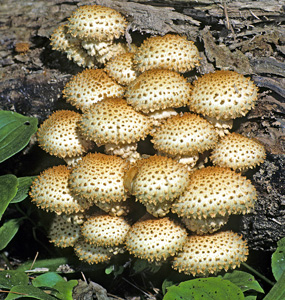Pholiota squarrosoides

Image Courtesy of Henry H. Mashburn
| Click to Enlarge |
| Click For Image Gallery |
|
Group of Fungi: Agarics Family: Strophariaceae Latin Name: Pholiota squarrosoides (Peck) Sacc. Common Name: Scaly Pholiota Description: Total height 2 1/2–6 in (6.5–15 cm); cap 1–4 in (2.5–10 cm) wide, convex at first but becoming nearly flat in age, yellow brown, upper surface with prominent, somewhat cone-like scales that are most numerous towards the center of the cap, surface of cap viscid when moist; gills closely spaced, pale yellow at first and then becoming brown to rust-brown; stalk 2–5.5 in (2.5–14 cm) long, 1/8–5/8 in (0.3–1.5 cm) in diameter, the same color as the cap, surface covered with scales; annulus present near top of stalk, white to pale yellow, cottony, flaring outward; spores brown in mass. Biological Role: Both a pathogen capable of killing some trees and a decomposer of wood. Habitat: Commonly occurring in large clusters around the base of living or dead broadleaf trees, stumps, logs or on the ground from buried wood. Geographical Distribution: Found throughout North America. Comments: Pholiota squarrosa is an almost identical fungus found in the same types of situations but distinguished on the basis of having a cap that is never viscid, gills that tend to have a greenish tint and several microscopic differences that can not be observed in the field. The prominent scales on the cap and stalk make Pholiota squarrosoides and Pholiota squarrosa rather distinctive fungi, even if it is not always easy to tell the two species apart. Both are regarded as unsuitable for human consumption. |
| Go Back |